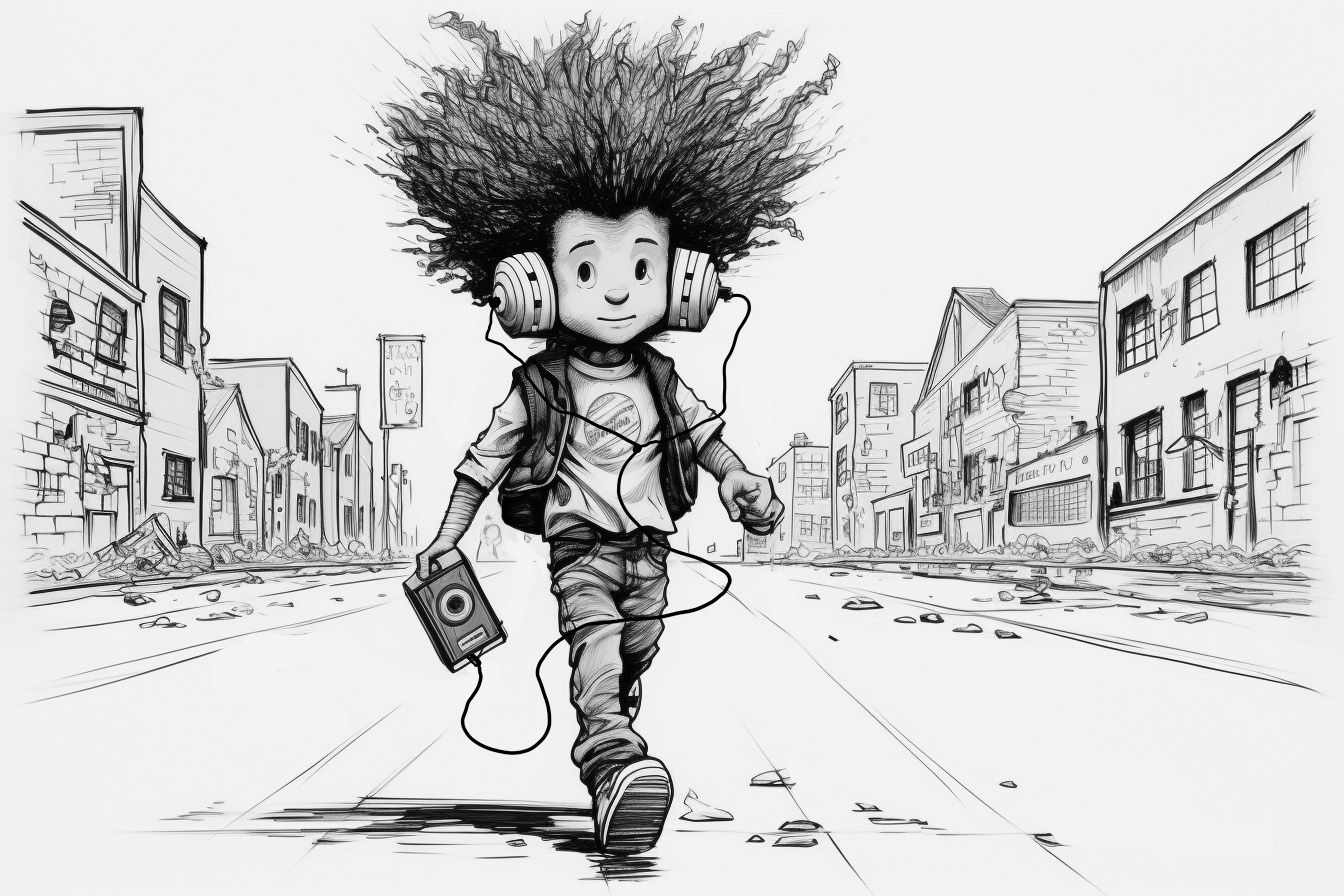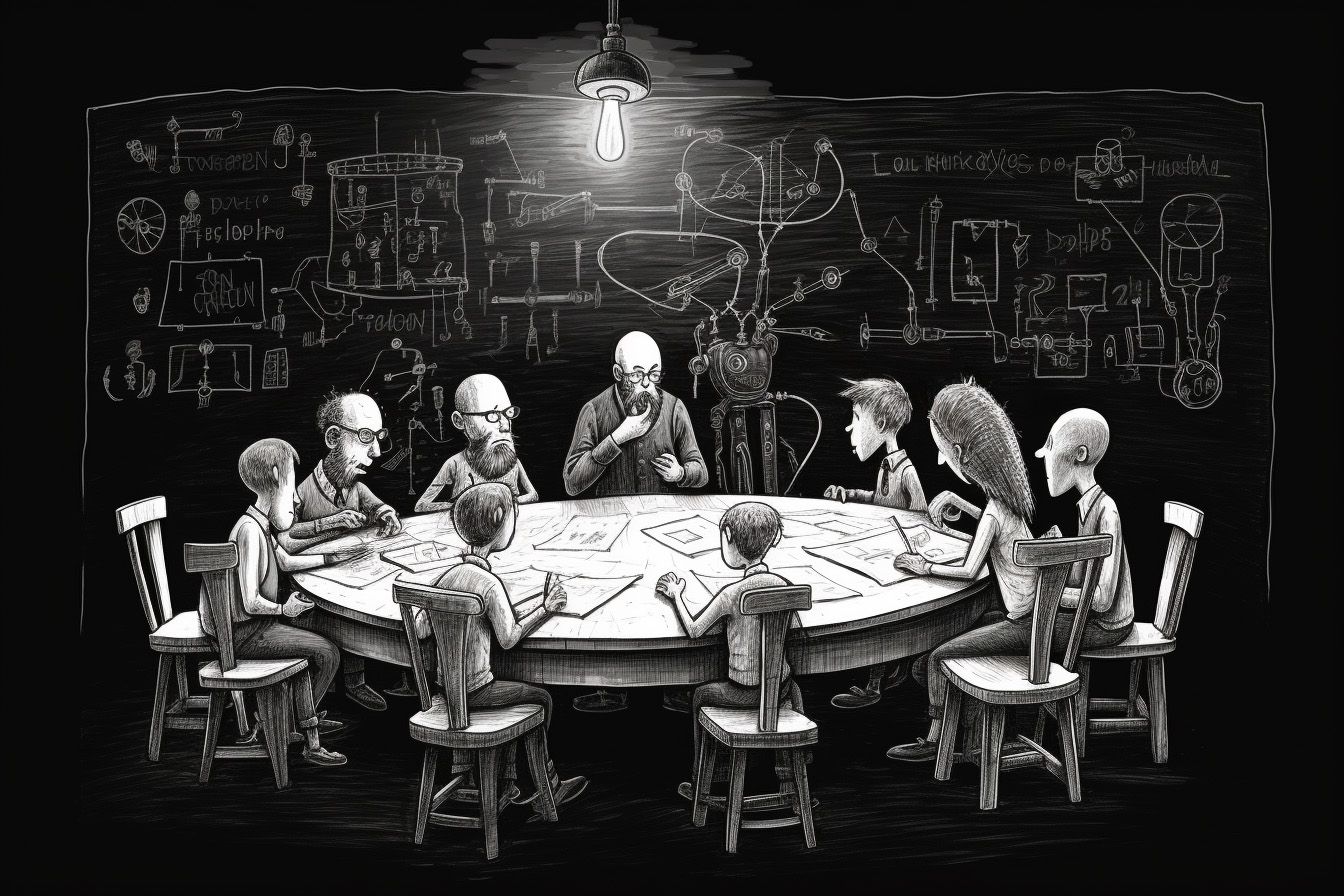Untangling the Future: From Wired Roots to Wireless Wonders


Envision, if you will, a world where every movement is followed by the tug of a leash, where the landscape of our desks is less "modern workspace" and more "spaghetti junction." If you're thinking, “Hey, that was my 1990s office!” then you're right on the money. We, humans, have an intrinsic desire to move, explore, and expand—so why did we spend decades tethered to our gadgets like they were our overprotective childhood chaperones?
From the snaky labyrinth of cables behind our TVs to the infuriating dance of detangling earphone wires, we've certainly come a long way. Now, before you start getting nostalgic about the 'good old wired days,' let's trace our steps back and figure out how we made the leap to the elegantly streamlined, wire-free world of today. We’re diving deep into the transition of cords to the cloud, of tangled to tangle-free. Let's unravel the story, one twisted wire at a time.
A Love Letter to the Wires We Used to Know
Let's rewind a bit. (And when I say "rewind," I'm not talking about the digital tap-on-an-icon kind, but the literal finger-twirling-around-a-cassette-tape kind.) Ah, the '80s and '90s—when neon colours were in, hair was big, and our tech was...well, strung up.

Ever notice that many of our great technological achievements were, quite literally, on a leash? The rotary phone with its coiled handset cord; that thrilling moment when your landline phone got an upgrade to a longer wire, so you could actually walk around a bit while chatting.
Remember the original computer setup? Not just the sizeable bulky monitor or the humming CPU but also the clump of wires that interconnected every piece. You couldn’t just "slide to the left" without moving the whole ensemble. CD players? They skipped whenever you took a step too large. And earphones?
And while there was an odd comfort in the physicality of these wired connections—a tangible representation of the electronic pathways—they weren't without their quirks. There were real-world problems, like tripping over the Nintendo controller cable or the existential dread of untangling your headphones only to find one of the buds not working.
Now, why am I serenading our old wired compatriots? Well, to truly appreciate where we are, it's essential to tip our hats to where we began. As we bid our wired buddies farewell and embrace the sleek, magical world of invisible connections, it's like graduating from high school: A little nostalgic, slightly tear-jerking, but mostly exciting for the boundless possibilities ahead.
And oh boy, the horizon of wireless tech was shimmering with promise. But before we fly into that cosmos, let’s raise a toast to our trusty wired anchors that kept us grounded (sometimes quite literally) and paved the way for the future. Here’s to you, spools of multi-coloured cords; you might be in our tech drawers now, but you'll always have a special place in our digital hearts.
The Dawn of the Wireless Wizardry
There's an old adage that says, "You don't know what you've got until it's gone." But when it comes to wires, the moment they began to vanish, we were like, “Uh, why didn’t we do this sooner?”
So, how did we begin this magical transition from a world laced with wires to one where data floated invisibly in the air? Let’s set the scene: It's the late '90s, and while most of us were busy trying to figure out the Macarena or nursing our Tamagotchi pets back to health, tech gurus were having clandestine meetings about something called...

Wi-Fi.Picture it. A handful of these techies in a dimly lit room, a blueprint sprawled across the table, hands flailing wildly as they sketched out a future where information wasn’t just passed through cables but zapped through thin air. It sounded like pure fantasy—like pulling a rabbit out of a hat, but the rabbit was an email, and the hat was, well, nowhere to be seen.
But, like all great innovations, it started with a problem. With the rise of laptops and mobile devices, the demand for mobility was growing. The world was slowly waking up to the Internet, and people didn’t want to be confined to one spot just to check their AOL mail or play Minesweeper.
Enter the IEEE (Institute of Electrical and Electronics Engineers) with their 802.11 standards. Sure, it sounds like a droid’s name from a galaxy far, far away, but this was the seed that would sprout into our beloved Wi-Fi. Early adoption was slow; people were sceptical. "You're saying my computer will connect to the internet...through the air?" Scepticism ran rampant, just like our attempts to download a single song in under an hour.

But as with all evolutionary leaps, challenges are but stepping stones. As the technology refined, speeds accelerated, and those invisible waves became more reliable. Homes began adopting routers, coffee shops touted "Free Wi-Fi" on chalkboards, and suddenly, that labyrinth of cables at our feet started to look very... archaic.
This was just the tip of the wireless iceberg, though. As Wi-Fi was establishing its reign, another magical acronym was preparing to make its mark: Bluetooth. But that is a tale of short-range wizardry for another chapter. For now, let's bask in the glorious freedom that came with those first steps into the wireless age, a step that made our Macarena dance a whole lot less hazardous.
Bluetooth and the Tale of Tiny Triumphs
Alright, let's take a brief time-travelling pit stop in the early 2000s. The Y2K scare was behind us (remember that wild ride?), frosted tips were, for some inexplicable reason, a hairstyle choice, and there was a new, mysterious word floating around tech circles. Whispered in hushed tones, as if invoking some ancient spell: Bluetooth.
Now, Bluetooth didn’t exactly storm onto the scene with the dramatic flair of a boy band's debut album. Instead, its entrance was more akin to the quiet new kid in class who, over time, would prove to be a genius.
Originating from the amalgamation of efforts by Ericsson, Nokia, and Intel, and later joined by Toshiba, IBM, and others, Bluetooth got its quirky name from a 10th-century Scandinavian king, Harald "Bluetooth" Gormsson. Why? Well, legend has it: he was a fan of blueberries and also uniting different tribes and regions. Similarly, Bluetooth technology was all about bringing different devices together in sweet wireless harmony. And just like that, tech history had another delightful anecdote.

Initially, Bluetooth’s goals were modest. Think of it as Wi-Fi's humble cousin, focusing on short-range connections. It dreamt of a world where your phone could chat with your headset, where your laptop could whisper sweet nothings to your mouse, all without any pesky cords getting in the way.
The first Bluetooth gadgets were, let's face it, a little clunky. We all remember (or are trying to forget) that one guy, strutting around with a chunky headset sticking out of his ear, looking like a futuristic cyborg telemarketer. But, as with all fledgling tech, it grew, it evolved, and it shrank down to be less obtrusive.
The real charm of Bluetooth wasn’t just in its ability to cut cords but in its promise of a seamless, interconnected future. Suddenly, your car was having conversations with your phone, ensuring you never missed a call even when belting out early 2000s hits on the highway. Or your fitness tracker, collecting every step, every heartbeat, and transmitting it to your devices, making the age-old excuse "my dog ate my workout" no longer viable.
Bluetooth's low-energy iterations meant that not only could we communicate wirelessly, but we could do so without draining our devices faster than the time it took to master the Cupid Shuffle. Today, as we gaze upon a horizon of smart homes, wearable tech, and interconnected cities, let's not forget to high-five Bluetooth: our silent, ever-present partner in the wireless waltz.
Wi-Fi Waves and the Liberation of the Web
Now, let's sidestep from Bluetooth for a second. While it was playing matchmaker for our gadgets, another revolution was brewing—one that would redefine the meaning of “being online.” Enter Wi-Fi, the unsung hero that unshackled the internet from its physical confines.
Picture this: It's the early '90s. You want to "hop on the internet." That entails sitting down at a bulky desktop computer, hearing the screechy dial-up song (you know the one), and patiently waiting for a connection—hoping no one picks up the phone and kicks you offline. Fun times, right?
But then something miraculous happened. In the late '90s and early 2000s, companies like Aironet (later acquired by Cisco) began to offer products that promised a wireless connection to the internet. It felt like magic. No more cables? Surf the web from the couch? The kitchen? The backyard? It was like someone took the leash off our favorite pet, the internet, and said, “Run free!”
Wi-Fi's origins are pretty brainy, rooted in a radio technology known as "frequency-hopping spread spectrum" (try saying that three times fast) — fun fact: Hollywood actress Hedy Lamarr co-invented this tech during WWII. Yep, the glamorous starlet from the silver screen was also a savvy inventor.
But back to Wi-Fi. Its rise was meteoric. Homes, coffee shops, airports—everywhere you looked, people were installing these mysterious “routers” (and placing them next to the tallest plant in the house for the best signal). Laptops began shedding their Ethernet ports in favor of wireless cards. And we all learned the sacred art of finding and connecting to the strongest Wi-Fi signal—bonus points if it was unsecured.
Wi-Fi wasn’t just about getting online, though. It was about redefining where and how we lived our digital lives. Those early days of setting AOL Instant Messenger away messages from a laptop in the bedroom? Groundbreaking. Streaming a movie without a tangle of cables? Revolutionary.
Yet, as transformative as Wi-Fi has been, it's just one thread in the larger tapestry of our wireless journey. Each innovation, from Bluetooth to Wi-Fi and beyond, represents a stepping stone toward a vision of untethered possibilities. As we continue on this path, there’s still more to uncover, more ah-ha moments to be had, and more virtual frontiers to explore.
The Invisible Hands: Wireless Charging and Our Path to Total Freedom
Now, we've chatted about the wireless connections between our devices and the unseen frequencies that usher the internet to our fingertips. But there's still one wire left, a big thorn in our side. Yep, you've guessed it: the charging cable. The one string still physically anchoring our gadgets to the wall.
Remember those early days of cell phones? They were these brick-like things that, while revolutionary, had a battery life that felt like it lasted for approximately three text messages and a game of Snake. And when they cried out for energy, we'd plug them into their wired lifelines, waiting hours for them to rejuvenate.
Fast forward a bit, and along comes the idea that's as close to sorcery as tech can get: wireless charging. The first time someone plopped their phone on a charging pad and it began to refuel without any plug-in play was, well, it felt like a tech revelation. It's like we suddenly lived in a world where our tech devices were fed by osmosis.
But how does this wireless charging magic trick work? At its core, it's about good ol' electromagnetic fields. Science lesson alert: when you run electricity through a coil, it creates an electromagnetic field around it. If you bring a second coil close to it—like, say, in the back of your phone—it picks up on this field and turns it back into electricity. So, without wires touching, power is being transferred. It's like a silent, invisible dance of energy between two partners.
But, as cool as wireless charging is, it's more than just a neat party trick. It represents the culmination of our drive to cut cords out of our lives completely. It's not just about making things convenient—it's a philosophy. A statement. It's saying, "We don't need to be tied down. Not by data cables, not by internet lines, and sure as heck, not by charging cords."
However, while our current state of wireless charging still requires our gadgets to be in close proximity to a charging pad, the true dream? Charging our devices through the air as we go about our day, a bit like Wi-Fi but for power. Imagine your phone charging in your pocket as you sip coffee at a cafe or your smartwatch getting juice just by being on your wrist. That's the dream—and we're getting tantalizingly close.
So, as we stand on the cusp of this potentially wire-free utopia, where every trace of our once spaghetti-junction desks is but a distant memory, we have to wonder: What's the next leap? How much more accessible can our tech lives get? Let's plug (or, rather, unplug) into the next phase of our evolution!
The Unexpected Pitstops: Where Wireless Wobbled
If this was a road trip through the wireless universe, then around this point, we'd probably hit some unexpected bumps or maybe even a tire blowout on the highway of progress. Because, let's face it, as dreamy as a world without wires sounds, the journey hasn't been all smooth sailing.
Remember those early days of Bluetooth? You’d pair your device and think, "Ah, the future is here!" Then, two minutes later, your connection would drop, or there'd be some mysterious interference, and suddenly, the future looked a lot like trying to watch TV with a pair of rabbit ears—you had to find that just right spot.
And Wi-Fi! Oh boy, the promises it held. The dream of lounging in your backyard while surfing the web was sometimes dashed by the cruel reality of "limited connectivity." Or worse, your neighbors' signals were more potent than yours, leaving you wondering what magical device they had.
Even as tech has advanced, there've been skeptics among us (and rightly so). Questions popped up like moles in a whack-a-mole game: Is this safe? What about security? And the ever-looming: What happens if the Wi-Fi goes down? Dun, dun, dun!
But here's the magic of human innovation: For every hiccup and skeptical raised eyebrow, there's been a group of people (probably in a well-lit lab with whiteboards filled with diagrams) working tirelessly to tackle these challenges.
Battery life became the unsung hero, and the development of more robust and efficient power storage methods gave our wireless dreams some real legs. Enhanced encryption methods? They went from being an afterthought to a cornerstone of wireless communication, making sure our data was locked up tighter than Fort Knox.
And while there were moments when we may have collectively facepalmed or even thought about retreating to our wired safety blankets, these pitstops provided valuable lessons. They made the tech community pause, reevaluate, and ultimately innovate further.
So, while it's fun to imagine a seamless transition from a wired to a wireless world, the bumps, setbacks, and U-turns have made the journey so rewarding. Because let's be honest: A story without a bit of drama is just... well, a user manual. And who wants to read that?
The Endgame: Are Wires Becoming Fossils?
Now, when you’re a kid and think about the future, it’s filled with flying cars, telepathic communications, and pizzas that appear out of thin air. But for those of us who’ve been on this wild, tech-driven rollercoaster, the idea of an entirely wire-free world doesn’t seem that outlandish.
It’s fascinating how quickly "the future" sneaks up on you. One minute, you're wrestling with a dial-up connection; the next, you're streaming 4K videos while making dinner reservations via voice commands, with nary a wire in sight.
But let's play a little game of imagination: Picture your typical living space. The living room, with that massive TV. The kitchen, with all the gadgets on the counter. Your bedroom, with the nightstand cluttered with various charging devices. Now, poof! Remove all wires. Complete, utter wirelessness. Looks clean, right? Almost... peaceful?
The evolution doesn't stop there. Imagine, too, a future where the cables are gone, but the very concept of 'charging' becomes quaint. Enter the battery-less microcontroller. This isn't just a tech upgrade—it's a statement. It shouts to the world that our tech is not only free of cords but also free from the tether of needing constant power top-ups. Your keyboard, mouse, and remote are living their best lives without ever begging for a charge.
This is not just about aesthetics or about not tripping over cords. It’s a philosophy—a way of interacting with our tech-infused world. Each cord removed, each device that becomes wire-free (and charge-free) unshackles us just a little bit more, both physically and mentally. It’s the universe’s way of telling us, "Hey, less clutter, more freedom!"
Are we quite at the point where wires are obsolete? Not entirely. Like those old vinyl records or vintage Polaroid cameras, there will always be aficionados who swear by the “original” way. And, hey, there’s nothing wrong with a bit of nostalgia.
But for the majority of us? The trajectory is clear. The future is not just cordless but also endlessly enduring, shaping an environment where our interactions with tech are fluid, intuitive, and unburdened.
So, to answer the burning question: Are wires becoming fossils? They're well on their way. But like any good plot twist in a sci-fi story, there's always room for surprises. Keep your eyes peeled, and your devices untethered—the grand finale of our tech evolution is bound to be a showstopper.












